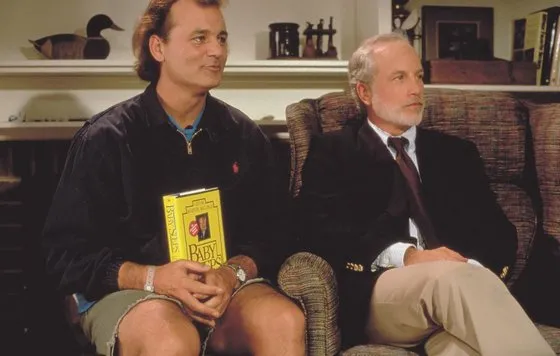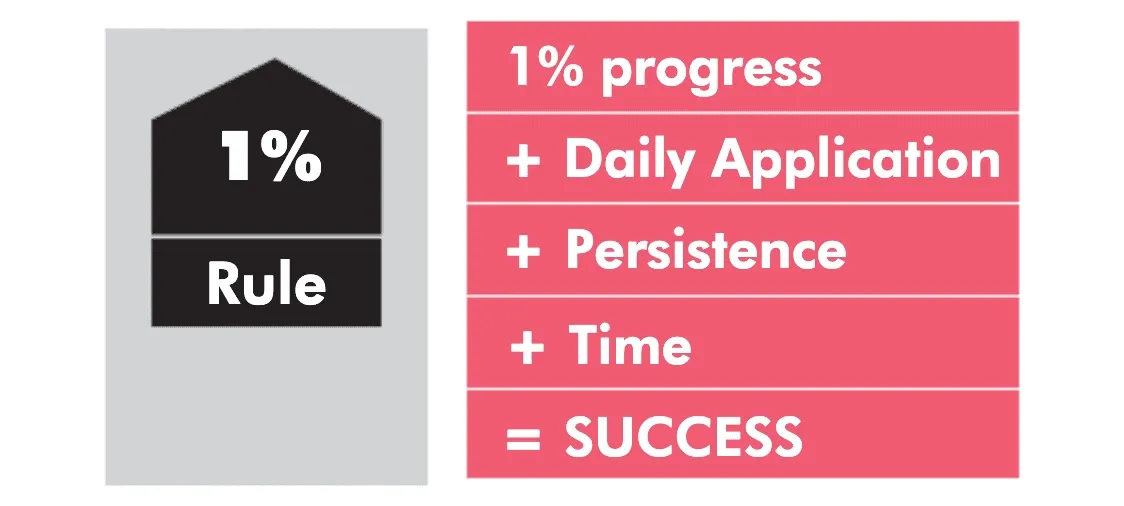Would you like to get everything and instantly?
The human is so arranged that we all want an easy and quick way to fulfill our desires and achieve goals. We all want quick change and great results. And so that for this you still do not need to do anything.
But the world is such that it cannot reward you with rapid change, especially when it comes to a big and important goal, such as personal development or building a successful business. You can't do everything at once. You can't get what you want quickly and effortlessly.
As Warren Buffett said, “No matter how great the talent or the effort, some things just take time. You won't be able to have a baby in one month, even if nine women get pregnant from you."
But if you understand and apply one simple principle, any goal will be achievable for you.
It's called "the art of small steps".

Bob and baby steps
And the first and the simplest thing I want to demonstrate this principle is the film by Frank Oz "What About Bob?" The main character is Bob Wiley (Bill Murray), who suffers from loneliness and mental disorders, has many fears and phobias (claustrophobia, fear of the crowd, fear of infections and infection, etc.) that limit his life. He comes to the first appointment with a new psychotherapist, but finds out that he cannot immediately start psychotherapy with him, since he is going on vacation. But the doctor gives Bob his new book "Baby Steps", and suggests using her main rule - "baby steps - to a big goal".

The doctor says: “When you leave, do not think about how you will get out of the building, think about how you will get out of this room. When you go out into the corridor, think only of the corridor. And so on.. In small steps.."
Bob literally understood the doctor's advice and began to walk everywhere "with childish steps." He began to do what he had not done before - communicate more, open up more to people, act more. And it gave excellent results. Bob managed to overcome his problems, returned to normal life, and even became a psychologist.
This is a bit of a comical situation, but it has a deep meaning. To reach your goal, you do not need to try to jump to it in one heroic jump, but you need to move towards it, make a little effort each time.
Zone of proximal development
Soviet psychologist Lev Semenovich Vygotsky introduced the concept of "zone of proximal development" into psychology when he considered and spoke about the development of children. What it is?
Vygotsky meant the existing relationship between the learning process and the mental development of the child. Each child, being at his point of development, has already acquired skills in the form of automatism. This is a familiar and comfortable situation for him. And in order for the child to develop, each next task must be a little more difficult, but doable by the forces of the developing child.

It is very important to choose the right task. If the task is easy enough, then the child will quickly complete it, remaining at the same point of development where he was. If you give the task more than the child's abilities, he will not cope and will most likely stop taking the initiative for a while. After a new successful experience, the new acquired ability becomes habitual, and turns into a platform for further development.
The same applies to an adult - he needs to master new skills gradually, in appropriate increasing complexity and consistency. These skills are called "closest" because a person is close to mastering them, but needs more practice and support in order to perform these actions on their own after a while.
The zone of proximal development is mobile. As the student acquires new skills and abilities, this zone gradually moves forward.
And this rule is followed by most successful people. In the biographies of many great personalities, one can notice one thing in common - they all tried to become a little better. For example, if you are studying a foreign language - today you memorized a few new words, tomorrow you worked a little on pronunciation, then learned a little grammar - and over time, your knowledge of a foreign language becomes noticeably better.
Accumulation effect or 1% rule
The situation when a very small superiority increases over time, scientists call the cumulative advantage, or the effect of accumulation.
The idea behind this theory is very simple - if you improve many insignificant elements of your business by a small percentage, for example, if your employees become one percent more competent and attentive to customers, if the quality of goods improves slightly, if costs are slightly reduced, then in the end, step by step, one day you will make your business very successful.
This phenomenon can also be called the 1% rule (The 1 Percent Rule). It states that over time, most rewards in a given area will accrue to individuals, teams, and organizations that maintain a 1% advantage over existing options.

This means you don't have to be twice as good to get twice the results. It's important to be a little better. And be consistent in this.
Continue to act!
Perhaps in the first stage there may be no clear signs that something is changing, and the very idea that your efforts will lead to only one percent improvement can kill all the motivation to do it further.
And many people do get frustrated and give up too quickly.
But there is no quick and easy way to truly achieve something of value.
It takes time to change. Sometimes things are slow and tedious. And not everyone has the strength to do it. But you will never change your life until you change something that you do every day. And the whole secret of success is regularity and consistency. And even if your changes seem small and imperceptible, they do happen.
For example, bodybuilders do not gain massive mass or win competitions by performing the same movements, lifting the same weight. Over the years, they constantly increase the weight and the level of stress on the muscles, and this leads to growth and obvious progress and victories.
While most people do not feel it necessary to waste time on subtle small changes, you are confidently approaching your goal. And when the accumulation effect works, then, as if by the effect of a butterfly, one next small effort can change your whole life.
Any work becomes a masterpiece after an endless cycle of improvements. Recently I read that under the last layer of paint on da Vinci's painting "Mona Lisa" there is a huge number of strokes that were not included in the final version.
So, let's formulate briefly the simplest formula for success.
Consistency and constancy of small efforts over a long period of time create the desired result.
And finally, words from the prayer of Antoine de Saint-Exupery.
“Lord, I'm not asking for miracles or mirage, but for the power of every day. Teach me the art of small steps..
..Teach me to properly manage the time of my life. Give me a subtle flair to distinguish the primary from the secondary. Help me understand that dreams cannot be help. No dreams of the past, no dreams of the future. Help me to be here and now and take this moment as the most important.
..I know that many problems are solved, if nothing is done, so teach me patience.
Teach me the art of small steps".
